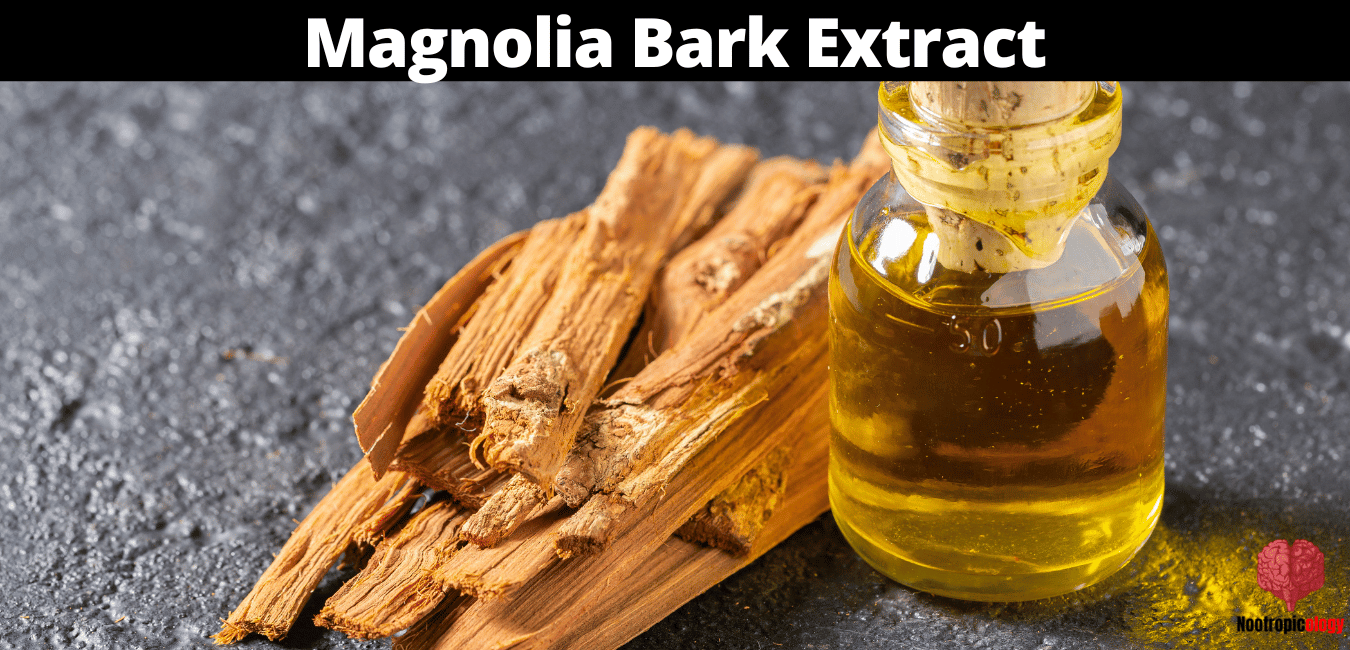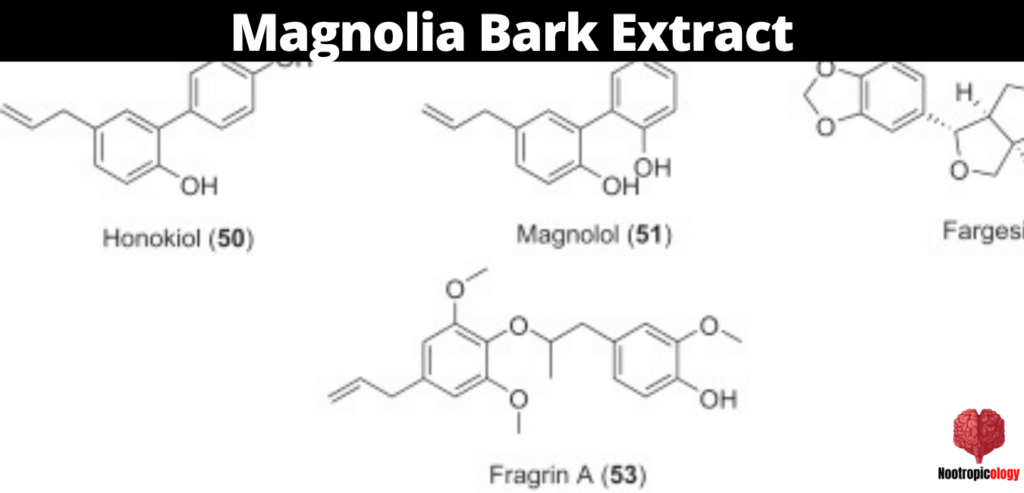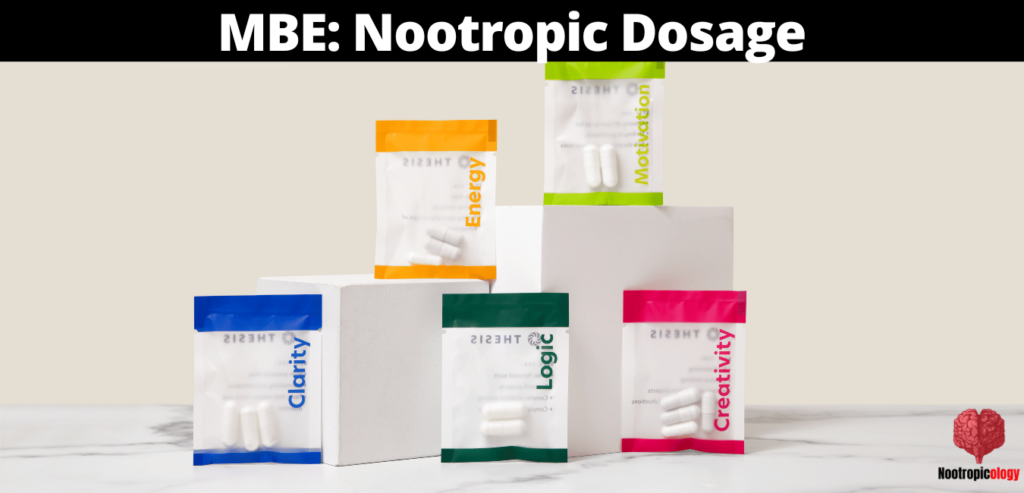Magnolia Bark Extract Nootropic Review: Benefits, Side Effects & Dosage
Throughout my years of delving deep into the complex world of nootropics, I've encountered myriad compounds, each holding its unique allure and promise.
Yet, amidst the vast ocean of 'brain boosters', the Magnolia Bark Extract (MBE) stands out as a fascinating chapter in this ongoing exploration. Its whispers echo not just in today's cutting-edge labs but reverberate through the ancient corridors of traditional Chinese medicine.
For over a millennium, these very halls have revered the bark of the Magnolia tree, particularly from the species Magnolia officinalis and Magnolia obovata, as a remedy for stress, anxiety, and even digestive issues.
So, today, let's take a scientific deep-dive into the world that is Magnolia Bark and see how effective it is as a nootropic.
Magnolia Bark Extract Nootropic Summary
- Source & Constituents: Magnolia Bark Extract (MBE) is derived from the barks of Magnolia officinalis and Magnolia obovata. Its primary active constituents are magnolol and honokiol.
- Nootropic Benefits: MBE offers a range of cognitive enhancements including: Memory improvement, Focus and attention enhancement, anxiolytic and potential anti-depressant properties.
- Mechanism of Action (MoA): MBE's cognitive benefits stem from its interactions with GABA receptors, antioxidative properties, and modulation of neurotransmitter systems.
- Stacking: MBE can be combined with other nootropics like L-Theanine, Bacopa Monnieri, and Rhodiola Rosea for synergistic effects. Adjusting dosages and monitoring for interactions is crucial.
- Dosage Recommendations: For cognitive benefits, a dosage ranging from 200 mg to 400 mg of standardized MBE (around 90% magnolol and honokiol) is recommended daily. Dosages can vary based on individual sensitivity and the desired effect.
Magnolia Bark Extract: Origin and Composition


Magnolia Bark Extract, sourced from the Magnolia tree, has long been a revered ingredient in Traditional Chinese Medicine (TCM). The Magnolia genus, comprising over 200 species, has its roots deep in evolutionary history, with certain species dating back nearly 100 million years.
Predominantly, Magnolia officinalis and Magnolia obovata have been the species of choice in medicinal preparations.
In TCM, the bark, referred to as "Houpu," is used not just as an isolated remedy but often in conjunction with other herbs in formulas such as "Banxia Houpu Tang," a concoction believed to address stagnation in the body and regulate the flow of 'Qi' or energy.
Chemical Composition: A Dive into Phytochemistry
At the heart of Magnolia Bark Extract's therapeutic properties lies its rich phytochemical profile. Two neolignan compounds, in particular, have piqued the interest of the scientific community:
- Magnolol (MAG): A bioactive compound, magnolol is a hydroxylated biphenyl compound, possessing a range of pharmacological activities. From its notable anti-inflammatory actions to its neuroprotective capabilities, magnolol offers an extensive therapeutic profile.[1]
- Honokiol: Another biphenyl compound, honokiol is often studied in tandem with magnolol due to their structural similarity. It showcases a range of pharmacological actions, from antioxidative to anxiolytic effects. Notably, honokiol can readily cross the blood-brain barrier (BBB), making it particularly relevant for neurological and cognitive applications.[2]
Furthermore, the bark extract also contains an assortment of essential oils, tannins, and flavonoids, each contributing to its multifaceted therapeutic potential.
It's worth noting that the precise composition of MBE can vary based on extraction methods, the specific species of Magnolia utilized, and environmental factors influencing the growth of the tree.
How Does Magnolia Bark Extract Work (Mechanism of Action)?


The intricate dance of molecules within Magnolia Bark Extract doesn’t merely stop at offering traditional benefits; they have, over the years, showcased a promising potential to act on cognitive and neurological pathways, aligning with the attributes of nootropics.
Interaction with GABA Receptors: The Calm Beneath the Cognitive Storm
The brain's neurotransmitters are the key players in dictating our mood, cognition, and overall neurological health. One such crucial neurotransmitter is gamma-aminobutyric acid (GABA). GABA is an inhibitory neurotransmitter, pivotal in reducing neuronal excitability and inducing relaxation.[3]
Compounds like honokiol, found in MBE, are known to interact with GABA receptors, specifically the benzodiazepine site of the GABA_A receptors.
By modulating these receptors, honokiol can promote anxiolytic effects, thus enhancing mood and reducing stress—a critical element in the pursuit of cognitive clarity.[4]
Anti-inflammatory Properties: A Guardian for the Brain
Inflammation, when unchecked, can be detrimental to brain health, often serving as a precursor to cognitive decline. Magnolol, one of MBE's primary bioactive compounds, has shown significant anti-inflammatory properties.[5]
By inhibiting the NF-kB pathway—a key player in inflammatory responses—magnolol can potentially offer neuroprotection. The relevance? A reduction in neural inflammation can enhance cognitive function, memory recall, and delay onset of neurodegenerative conditions.[6]
Neuroprotective Impact: Shielding the Brain's Fortress
Neurodegeneration is an alarming reality of our times, with conditions like Alzheimer's and Parkinson's affecting millions worldwide. MBE's honokiol has showcased potential neuroprotective effects, attributed to its antioxidative properties.
By scavenging free radicals and reducing oxidative stress, honokiol could play a role in staving off neurodegenerative conditions, thus ensuring cognitive longevity.[7]
To truly appreciate the magnitude of Magnolia Bark Extract's potential as a nootropic, we must further explore its direct cognitive benefits and effects below.
Magnolia Bark Extract's Nootropic Benefits


In the realm of cognitive enhancement, Magnolia Bark Extract offers a blend of ancient wisdom and modern scientific validation.
Its complex phytochemistry reveals a myriad of benefits, many of which have direct implications for cognitive enhancement and overall brain health.
Cognitive Enhancement: Memory Improvement
Memory, the cornerstone of cognitive function, is often vulnerable to age, stress, and external toxins. Magnolol, abundant in MBE, has shown promise in improving memory impairment.
Studies on rodents have demonstrated its potential in reversing scopolamine-induced memory deficits, thus indicating its role in cholinergic pathway modulation—a pivotal system for memory processes.[8]
Focus and Attention
In our hyper-stimulated world, maintaining focus is a formidable challenge.
MBE’s anxiolytic properties, primarily stemming from its interaction with GABA receptors, can result in reduced mental noise, thereby promoting sustained attention.
This has implications not just for day-to-day tasks but also for conditions like ADHD where focus is intrinsically compromised.
Mood Regulation: Anxiety Reduction
As previously discussed, honokiol's affinity for the GABA_A receptors, particularly the benzodiazepine site, gives MBE its potent anxiolytic effects.
With reduced anxiety, the brain can function more efficiently, process information rapidly, and improve decision-making capacities.[9]
Potential Anti-depressant Properties
Depression, often a result of neurotransmitter imbalances, can significantly hamper cognitive function.
Preliminary studies indicate that MBE might exert anti-depressant effects by modulating serotonergic and dopaminergic systems, though more research is needed to ascertain its full potential in this realm.[10]
Sleep and Relaxation: Natural Sedative Properties
Sleep is vital for cognitive rejuvenation.
Honokiol's interaction with GABA_A receptors not only confers anxiolytic effects but also has sedative properties. Improved sleep quality can subsequently lead to enhanced cognitive functions, improved memory recall, and increased focus.[11]
Neuroprotective Benefits
As discussed, the antioxidative properties of MBE's constituents, especially honokiol, play a significant role in neuroprotection.
By reducing oxidative stress, they contribute to a healthy neural environment, crucial for optimal cognitive function.
Magnolia Bark Extract is not just another natural compound; it's a symphony of molecules, each playing its part in the grand orchestra of cognitive enhancement. In the next section, we will look into its side effects and safety profile. So without further ado, let's continue.
Analysis: Magnolia Officinalis Extracts in Alzheimer's Disease
According to a study conducted on Magnolia officinalis and its impact on memory impairment and amyloidogenesis in a transgenic mouse model of Alzheimer's Disease[12] Lee et al. showcased the historical use of Magnolia bark in oriental traditional medicine. These traditional practices emphasize the bark's role in treating neurosis, anxiety, and headaches.
What this means is that the bark of the Magnolia family possesses potent bioactive components. Lee et al. identified these components as honokiol, obovatol, magnolol, and 4-O-methylhonokiol.
They found that extracts, especially 4-O-methylhonokiol, demonstrated memory-improving functions in several animal models. This discovery positions Magnolia officinalis as a potential nootropic agent.
Lee et al. further reported that both the nutritional supplement (Magnolia Extract™) and the ethanol extract of Magnolia officinalis showed promise in ameliorating memory dysfunction in Alzheimer's Disease mouse models. Notably, the ethanol extract seemed to have a more pronounced effect.
However, it's essential to note the variability in efficacy. Lee et al. suggest that the therapeutic benefits of Magnolia extracts could differ based on cultivation areas and manufacturing methods.
Magnolia Bark Extract Side Effects & Safety Profile
Magnolia Bark Extract, like any therapeutic agent, is not without its caveats.
While it boasts a broad spectrum of benefits, it's paramount to remain cognizant of its potential side effects and interactions.
Here's an overview of the most common Magnolia Bark Extract side effects:
- Sedation: Due to its interaction with the GABA_A receptors, particularly via honokiol, one of the most reported side effects is sedation or drowsiness. While this can be advantageous for sleep induction, it might not be desirable during activities that demand alertness.
- Allergic Reactions: Though rare, some individuals might exhibit allergic reactions to MBE, manifesting as skin rashes, itching, or even respiratory issues.
- Digestive Issues: In higher doses, MBE can cause gastrointestinal disturbances such as nausea, diarrhea, or abdominal discomfort.
Interactions with Other Drugs
Given MBE's sedative properties, concurrent use with other sedatives or benzodiazepines may potentiate the sedative effects, leading to excessive drowsiness or even respiratory depression.
Anti-depressants
MBE's potential modulation of serotonergic and dopaminergic systems suggests caution when co-administered with certain antidepressants, especially SSRIs or MAOIs, to avoid the risk of serotonin syndrome.
Magnolia Bark Extract Nootropic Dosage Recommendations


Navigating the optimal dosage of Magnolia Bark Extract (MBE) for cognitive enhancement can be intricate. Not only does it vary based on individual sensitivity and desired effects, but also on the context in which it's taken, such as standalone use versus stacking with other nootropics.
Here's a detailed guide on how to approach MBE dosing for nootropic purposes.
Standalone MBE Dosage
When consumed solely for its nootropic benefits:
- Standard Dosage: For cognitive enhancement, dosages ranging from 200 mg to 400 mg of standardized MBE (containing around 90% magnolol and honokiol) are recommended. This range can help enhance memory, focus, and mood regulation.
- Sleep Aid: If leveraging its sedative properties for improved sleep, a higher end of the dosage range or slightly above, approximately 400 mg to 500 mg, taken an hour before bedtime, might be more effective.
Nootropic Stacks
Stacking refers to the practice of combining multiple nootropics to achieve synergistic benefits. When stacking MBE with other nootropics, it's important to adjust dosages and monitor for interactions.
- MBE and L-Theanine: L-Theanine, commonly found in tea, is known for promoting relaxation without sedation. A combination of 200 mg MBE with 100 mg L-Theanine can offer enhanced focus and reduced anxiety.
- MBE and Bacopa Monnieri: Bacopa is a revered adaptogen and nootropic herb. Stacking 200 mg MBE with 150 mg Bacopa Monnieri can potentiate memory enhancement and cognitive clarity.
- MBE and Rhodiola Rosea: Rhodiola is known for combating fatigue and enhancing cognition. Combining 200 mg MBE with 200 mg Rhodiola Rosea might offer balanced energy, focus, and mood elevation.
Clinical Dosages
In clinical settings, the dosage of MBE varies depending on the condition being treated.
- Stress and Anxiety: Clinical studies often employ dosages ranging from 250 mg to 500 mg daily, divided into two doses.
- Depression: Clinical trials investigating MBE's antidepressant properties might use dosages of up to 500 mg daily, though results and recommendations remain preliminary.
Considerations and Caveats
- Tolerance: Over time, the body might develop tolerance to MBE, necessitating an upward adjustment in dosage. It's advisable to occasionally cycle off MBE to prevent tolerance buildup.
- Purity and Source: Ensure that the MBE supplement chosen is of high quality, standardized, and devoid of contaminants. The purity of magnolol and honokiol content can significantly influence dosage requirements.
- Individual Sensitivity: Like all nootropics, individual sensitivity to MBE can vary. It's wise to start with a lower dose and gradually titrate upwards while monitoring for effects and side effects.
Frequently Asked Questions (FAQ)
What is Magnolia Bark Extract (MBE) and its primary constituents?
Magnolia Bark Extract (MBE) is derived from the bark of magnolia trees, primarily Magnolia officinalis and Magnolia obovata. Its primary active constituents, known for their therapeutic properties, are magnolol and honokiol.
How does MBE function as a nootropic?
MBE functions as a nootropic by enhancing memory, promoting focus, regulating mood through its anxiolytic and potential anti-depressant properties, and by aiding in sleep due to its natural sedative effects. Its interactions with GABA receptors, antioxidative properties, and modulation of neurotransmitter systems play pivotal roles in these cognitive benefits.
Can MBE be stacked with other nootropics?
Yes, MBE can be stacked with other nootropics such as L-Theanine, Bacopa Monnieri, and Rhodiola Rosea. However, when stacking, it's essential to adjust dosages and be aware of potential synergistic effects or interactions.
What is the recommended dosage of MBE for cognitive enhancement?
For cognitive enhancement, a typical recommended dosage ranges from 200 mg to 400 mg of standardized MBE (containing around 90% magnolol and honokiol) daily. However, this can vary based on individual sensitivity and desired effects.
Is it safe to take MBE every day?
Generally, MBE is considered safe for daily consumption, especially within the recommended dosage range. However, it's wise to occasionally cycle off MBE to prevent tolerance buildup and ensure its continued effectiveness.
How does MBE compare to synthetic nootropics?
MBE offers a more holistic approach to cognitive enhancement, leveraging natural compounds with multi-faceted benefits. While synthetic nootropics might have targeted and potent effects, MBE combines cognitive enhancement with additional benefits like mood regulation, antioxidative properties, and natural sedative effects, all with a generally milder side effect profile.
My Final Thoughts: Magnolia Bark Extract as a Nootropic
Navigating the intricate landscape of supplements, it's evident that not all are created equal. Magnolia Bark Extract stands out, not only as a potent herbal treatment but also as a noteworthy member within the vast family of vitamins and supplements. The broad spectrum of its uses, from managing symptoms of various conditions to potential cancer treatments, sets it apart.
Preliminary studies, especially those involving mice, have indicated significant antioxidant activity, hinting at its potential to combat oxidative stress—a common culprit behind many ailments.
Furthermore, while animal models like mice have given us valuable insights, human studies are crucial. They not only validate the findings from mice studies but also ensure the results are directly translatable to our physiology. Recent human studies have begun to corroborate many of the claims traditionally associated with this extract.
Products that harness the benefits of MBE often tout its antioxidant properties, but it's the potential liver-protective activity that piques the interest of many scientists. Given the liver's role in detoxification, any supplement or treatment that supports its function holds immense value.
However, as with all supplements and herbal products, discernment is key. While the allure of MBE is undeniable, grounded in both ancient wisdom and modern science, it's paramount to approach its consumption with an informed perspective, being aware of its multifaceted benefits and potential caveats.
- Ranaware, Abhishek Manoj et al. “Magnolol: A Neolignan from the Magnolia Family for the Prevention and Treatment of Cancer.” International journal of molecular sciences vol. 19,8 2362. 10 Aug. 2018, doi:10.3390/ijms19082362 ↑
- Dai, Xiaolin et al. “The Neuropharmacological Effects of Magnolol and Honokiol: A Review of Signal Pathways and Molecular Mechanisms.” Current molecular pharmacology vol. 16,2 (2023): 161-177. doi:10.2174/1874467215666220223141101 ↑
- Alexeev, Mikhail et al. “The natural products magnolol and honokiol are positive allosteric modulators of both synaptic and extra-synaptic GABA(A) receptors.” Neuropharmacology vol. 62,8 (2012): 2507-14. doi:10.1016/j.neuropharm.2012.03.002 ↑
- Woodbury, Anna et al. “Neuro-modulating effects of honokiol: a review.” Frontiers in neurology vol. 4 130. 11 Sep. 2013, doi:10.3389/fneur.2013.00130 ↑
- Walker, Joel M et al. “Identification of Magnolia officinalis L. bark extract as the most potent anti-inflammatory of four plant extracts.” The American journal of Chinese medicine vol. 41,3 (2013): 531-44. doi:10.1142/S0192415X13500389 ↑
- Zhang, Jianhong et al. “Insights on the Multifunctional Activities of Magnolol.” BioMed research international vol. 2019 1847130. 23 May. 2019, doi:10.1155/2019/1847130 ↑
- Park, Cheol et al. “Honokiol ameliorates oxidative stress-induced DNA damage and apoptosis of c2c12 myoblasts by ROS generation and mitochondrial pathway.” Animal cells and systems vol. 24,1 60-68. 28 Dec. 2019, doi:10.1080/19768354.2019.1706634 ↑
- Lu, Sheng-Hua et al. “Magnolol ameliorates ligature-induced periodontitis in rats and osteoclastogenesis: in vivo and in vitro study.” Evidence-based complementary and alternative medicine : eCAM vol. 2013 (2013): 634095. doi:10.1155/2013/634095 ↑
- Qu, Wei-Min et al. “Honokiol promotes non-rapid eye movement sleep via the benzodiazepine site of the GABA(A) receptor in mice.” British journal of pharmacology vol. 167,3 (2012): 587-98. doi:10.1111/j.1476-5381.2012.02010.x ↑
- lLi-Tao Yi, et al. “Antidepressant-like Synergism of Extracts from Magnolia Bark and Ginger Rhizome Alone and in Combination in Mice.” Progress in Neuro-Psychopharmacology and Biological Psychiatry, Elsevier, 11 Mar. 2009, www.sciencedirect.com/science/article/abs/pii/S027858460900058X. ↑
- Sigel, Erwin, and Michael E Steinmann. “Structure, function, and modulation of GABA(A) receptors.” The Journal of biological chemistry vol. 287,48 (2012): 40224-31. doi:10.1074/jbc.R112.386664 ↑
- Lee, Young-Jung et al. “A Comparison between Extract Products of Magnolia officinalis on Memory Impairment and Amyloidogenesis in a Transgenic Mouse Model of Alzheimer's Disease.” Biomolecules & therapeutics vol. 20,3 (2012): 332-9. doi:10.4062/biomolther.2012.20.3.332 ↑
